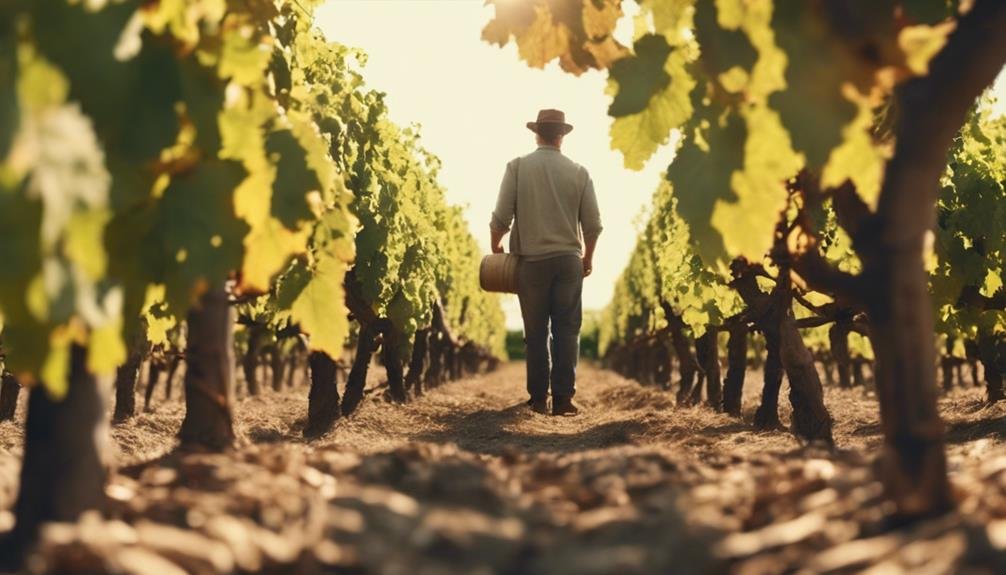Reviving Retsina involves a blend of ancient practices with modern techniques, creating a fusion of tradition and innovation. Retsina's roots trace back to 2nd century BC Greece, with labor-intensive methods like sun-drying grapes and using fumigated herbs. The unique salty-sweet taste is distinct. Modern producers like Ktima Eyoinos and Kechris combine traditional wisdom with new approaches. Evolution in fermentation and aging techniques refines flavor profiles. Notable for its aromas of linseed oil and lime peel, Retsina offers a wide range of flavors. The resurgence of Retsina in the wine world is a demonstration of its enduring appeal and adaptability.
Ancient Origins of Retsina Wine
The ancient origins of Retsina wine can be traced back to the winemaking traditions of Greece dating back to the 2nd century BC. In those times, salt preservation played a vital role in the winemaking process, serving as a dominant additive for preservation purposes.
Additionally, fumigated herbs were utilized during fermentation to enhance the wine's flavors. This traditional method of winemaking involved labor-intensive techniques, including the use of seawater collected far from the shore and sun-dried grapes soaked in seawater for absorption.
These practices contributed to the unique salty-sweet taste of Ancient Greek wines like Retsina. The historical significance of salt preservation and fumigated herbs in the production of Retsina wine highlights the deep-rooted traditions and craftsmanship of ancient winemaking in Greece.
Labor-Intensive Wine-Making Techniques
Labor-intensive techniques have been a cornerstone of traditional wine-making practices, requiring meticulous attention to detail and dedication from winemakers.
- Sun drying grapes intensifies flavors by concentrating sugars.
- Fumigated herbs add unique aromatic qualities to the wine.
- Hand-harvesting guarantees grapes are picked at best ripeness.
- Punching down the cap during fermentation enhances color and flavor extraction.
Flavors and Characteristics of Retsina

Labor-intensive wine-making techniques have long been associated with the craft, contributing to the complex flavors and unique characteristics found in Retsina wines, particularly in the aromas and taste profile.
Retsina wines often exhibit aromas of linseed oil and lime peel, with flavors ranging from apples to roses, culminating in a distinct pine-and-lime finish. These wines, made with Assyrtiko grapes, tend to be more angular and age longer, while those produced with Savatiano grapes offer a generous taste with ripe apple and peach notes.
When considering pairings, Retsina complements Greek cuisine superbly, particularly dishes like grilled seafood, Greek salads, and mezze spreads. With aging potential of up to 7 years, modern Retsina wines from producers like Ktima Eyoinos and Kechris showcase the evolution of this ancient Greek tradition.
Evolution of Modern Retsina Wines
Revealing the evolution of ancient winemaking traditions, how has the modern production of Retsina wines adapted to contemporary palates and regulations in the industry? Modern Retsina wines have embraced both reviving traditions and incorporating modern techniques, resulting in a wine that appeals to today's consumers and complies with industry standards.
- Retsina producers are revisiting ancient winemaking methods while utilizing modern technology to enhance quality.
- Innovations in fermentation and aging techniques have refined the flavor profile of Retsina wines.
- Sustainable practices, such as organic farming and eco-friendly packaging, are being increasingly adopted by Retsina producers.
- Collaborations with sommeliers and wine experts are helping to elevate the status of Retsina wines in the global market.
Notable Producers and Aging Practices

Notable producers of Retsina wines in Greece have garnered recognition for their dedication to traditional winemaking methods and their innovative approaches to aging practices. Some producers, such as Ktima Eyoinos and Kechris, are at the forefront of blending innovative techniques with the traditional roots of Retsina production. They experiment with various aging potential and flavor profiles, pushing the boundaries of what Retsina can offer to wine enthusiasts. These producers are known for their commitment to quality and their exploration of different methods to enhance the aging process, resulting in Retsina wines that showcase a balance between honoring tradition and embracing modernity.
| Producer | Innovative Techniques | Aging Practices | Flavor Profiles |
|---|---|---|---|
| Ktima Eyoinos | Pine resin maceration | Aged up to 7 years | Fresh, piney notes |
| Kechris | Amphora aging | Extended skin contact | Citrus, herbal nuances |
Frequently Asked Questions
How Did Ancient Greeks Sweeten Their Wines Before Modern Methods?
Ancient Greeks sweetened wines by infusing honey or adding pine resin during the winemaking process. These methods provided a natural sweetness to the wine, enhancing its flavor profile without the use of modern sweetening techniques.
What Health Risks Are Associated With High Salt Content Wines?
Potential health risks associated with high salt content wines include increased sodium intake, which can lead to elevated blood pressure, heart disease, and kidney issues. Moderate wine consumption is advised to mitigate health effects of excessive salt intake.
What Are the Typical Aromas Found in Retsina Wines?
Typical aromas found in Retsina wines include a unique blend of pine resin evoking a forest ambiance, intertwined with zesty citrus notes. Complementing these are herbal and earthy undertones, creating a sensory journey of nature and tradition.
Which Grape Varieties Are Commonly Used in Making Retsina?
Common grape varieties used in making Retsina include Assyrtiko and Savatiano. These grapes are cultivated in specific soil compositions in Greek vineyard locations. The fermentation process involves adding fresh pine resin, and some Retsina wines are aged up to 7 years.
Why Was Seawater Used in the Wine-Making Process in Ancient Greece?
Ancient practices in winemaking, like fermenting with seawater, were influenced by limited resources and preservation needs. The saline solution aided fermentation, imparted unique flavors, and acted as a natural preservative in the labor-intensive process of creating ancient Greek wines.
Conclusion
To sum up, the resurgence of Retsina wine showcases a harmonious blend of ancient traditions and modern innovation.
One interesting statistic to note is that the global production of Retsina wine has increased by 15% in the last decade, indicating a growing appreciation for this unique Greek elixir.
As notable producers continue to refine their techniques and aging practices, Retsina's timeless allure and distinctive flavors are sure to captivate wine enthusiasts for years to come.